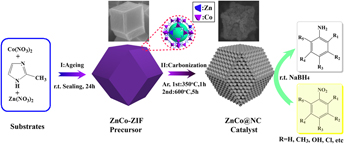Crossref Citations
This article has been cited by the following publications. This list is generated based on data provided by
Crossref.
Liu, Lei
Yang, Quanling
Jiang, Ming
Wang, Shan
Liu, Bin
Fang, Dong
Huang, Jing
Wang, Qing
Dong, Lijie
and
Xiong, Chuanxi
2018.
Ordered porous structure of nitrogen-self-doped carbon supporting Co3O4nanoparticles as anode for improving cycle stability in lithium-ion batteries.
Journal of Materials Research,
Vol. 33,
Issue. 9,
p.
1226.
Mahto, Madhusudan Kr.
Samanta, Dipanjan
Konar, Suraj
Kalita, Himani
and
Pathak, Amita
2018.
N, S doped carbon dots—Plasmonic Au nanocomposites for visible-light photocatalytic reduction of nitroaromatics.
Journal of Materials Research,
Vol. 33,
Issue. 23,
p.
3906.
Rong, Jian
Qiu, Fengxian
Zhang, Tao
Zhu, Yao
Xu, Jicheng
Guo, Qing
and
Peng, Xiaoming
2018.
Non-noble metal@carbon nanosheet derived from exfoliated MOF crystal as highly reactive and stable heterogeneous catalyst.
Applied Surface Science,
Vol. 447,
Issue. ,
p.
222.
Rong, Jian
Chen, Hongli
Qiu, Fengxian
Zhang, Tao
Zhu, Yao
Yang, Dongya
Xu, Jicheng
Rong, Xinshan
Guo, Qing
and
Peng, Xiaoming
2018.
In-situ immobilization and pyrolysis of metal-organic framework supported on biomorphic layered double hydroxides as highly active and stable heterogeneous catalyst.
Journal of the Taiwan Institute of Chemical Engineers,
Vol. 88,
Issue. ,
p.
78.
Ma, Wenlan
Li, Hui
Xu, Qian
Zhang, Yi
Wang, Wei
and
Wang, Jide
2018.
Au nanoparticle-doped Co3O4–CoFe2O4@SiO2 as a catalyst for visible-light-driven water oxidation.
New Journal of Chemistry,
Vol. 42,
Issue. 18,
p.
14757.
Huang, Dandan
Wu, Xueqian
Tian, Junwu
Wang, Xiaokun
Zhou, Zhihang
and
Li, Dongsheng
2018.
Assembling of a novel 3D Ag(I)-MOFs with mixed ligands tactics: Syntheses, crystal structure and catalytic degradation of nitrophenol.
Chinese Chemical Letters,
Vol. 29,
Issue. 6,
p.
845.
Wang, Minghua
Liu, Yongkang
Yang, Longyu
Tian, Kuan
He, Linghao
Zhang, Zhihong
Jia, Qiaojuan
Song, Yingpan
and
Fang, Shaoming
2019.
Bimetallic metal–organic framework derived FeO /TiO2 embedded in mesoporous carbon nanocomposite for the sensitive electrochemical detection of 4-nitrophenol.
Sensors and Actuators B: Chemical,
Vol. 281,
Issue. ,
p.
1063.
Aydan, Tursunjan
Yang, Chao
Xu, Yang
Yuan, Tongtong
Zhang, Min
Li, Hui
Liu, Xueming
Su, Xintai
and
Wang, Jide
2019.
A magnetic composite material derived from FeOOH decorated Cu-MOF and its catalytic properties.
Inorganic Chemistry Communications,
Vol. 102,
Issue. ,
p.
162.
Formenti, Dario
Ferretti, Francesco
Scharnagl, Florian Korbinian
and
Beller, Matthias
2019.
Reduction of Nitro Compounds Using 3d-Non-Noble Metal Catalysts.
Chemical Reviews,
Vol. 119,
Issue. 4,
p.
2611.
Khan, Shanza Rauf
Batool, Maria
Jamil, Saba
Bibi, Shamsa
Abid, Sobia
and
Janjua, Muhammad Ramzan Saeed Ashraf
2020.
Synthesis and Characterization of Mg–Zn Bimetallic Nanoparticles: Selective Hydrogenation of p-Nitrophenol, Degradation of Reactive Carbon Black 5 and Fuel Additive.
Journal of Inorganic and Organometallic Polymers and Materials,
Vol. 30,
Issue. 2,
p.
438.
Konnerth, Hannelore
Matsagar, Babasaheb M.
Chen, Season S.
Prechtl, Martin H.G.
Shieh, Fa-Kuen
and
Wu, Kevin C.-W.
2020.
Metal-organic framework (MOF)-derived catalysts for fine chemical production.
Coordination Chemistry Reviews,
Vol. 416,
Issue. ,
p.
213319.
Gholinejad, Mohammad
Esmailoghli, Hamid
and
Sansano, José M.
2020.
Human hair catalyzed selective reduction of nitroarenes to amines.
Canadian Journal of Chemistry,
Vol. 98,
Issue. 5,
p.
244.
Menezes, Tamires
Santos, Kátilla
Franceschi, Elton
Borges, Gustavo
Dariva, Cláudio
Egues, Silvia
De Conto, Juliana
and
Santana, Cesar
2020.
Synthesis of the chiral stationary phase based on functionalized ZIF-8 with amylose carbamate.
Journal of Materials Research,
Vol. 35,
Issue. 21,
p.
2936.
Asif, Iqra
Baig, Nadeem
Sher, Muhammad
Ul-Hamid, Anwar
Altaf, Muhammad
Mumtaz, Asad
and
Sohail, Manzar
2021.
MOF derived novel zero-valent iron @ graphitic carbon-based nanoreactors for selective reduction of hazardous 4-nitrophenol.
Cleaner Engineering and Technology,
Vol. 2,
Issue. ,
p.
100081.
Parveen, M.F.
Amala Jeya Ranchani, A.
Parthasarathy, V.
and
Anbarasan, R.
2021.
Efficient catalytic application of Cu-Fe bimetallic nanoparticles towards the preparation of bio-medically important polymer based Schiff bases.
Surfaces and Interfaces,
Vol. 25,
Issue. ,
p.
101197.
Abdelhameed, Reda M.
Al Kiey, Sherief A.
Wassel, Ahmed R.
and
El-Shahat, Mahmoud
2021.
Silver chromate doped Ti-based metal organic framework: synthesis, characterization, and electrochemical and selective photocatalytic reduction properties.
New Journal of Chemistry,
Vol. 45,
Issue. 21,
p.
9526.
Li, Zhaoqiang
Yang, Jingyi
Ge, Xiaoli
Deng, Ya-Ping
Jiang, Gaopeng
Li, Haibo
Sun, Guiru
Liu, Wenwen
Zheng, Yun
Dou, Haozhen
Jiao, Hailiang
Zhu, Jianbing
Li, Nan
Hu, Yongfeng
Feng, Ming
and
Chen, Zhongwei
2021.
Self-assembly of colloidal MOFs derived yolk-shelled microcages as flexible air cathode for rechargeable Zn-air batteries.
Nano Energy,
Vol. 89,
Issue. ,
p.
106314.
Purohit, Gunjan
and
Rawat, Diwan S.
2022.
Metal-Organic Frameworks (MOFs) as Catalysts.
p.
705.
Panda, Jagannath
Biswal, Soumya Prakash
Jena, Himanshu Sekhar
Mitra, Arijit
Samantray, Raghabendra
and
Sahu, Rojalin
2022.
Role of Lewis Acid Metal Centers in Metal–Organic Frameworks for Ultrafast Reduction of 4-Nitrophenol.
Catalysts,
Vol. 12,
Issue. 5,
p.
494.
Zhang, Tingshi
Yang, Chengkai
Li, Borong
Zhang, Yuanming
Zhuang, Zanyong
and
Yu, Yan
2022.
Atomically dispersed and oxygen deficient CuO clusters as an extremely efficient heterogeneous catalyst.
Nanoscale,
Vol. 14,
Issue. 13,
p.
4957.
